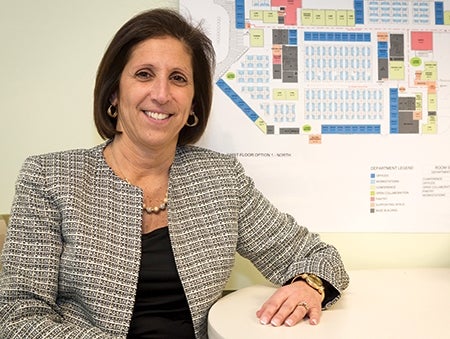UMass Memorial decentralizing
 Renee Mikitarian-Bradley, UMass' senior director for real estate, wouldn't detail where the organization's expenses will take place, but she did say it will focus on patient needs.
Renee Mikitarian-Bradley, UMass' senior director for real estate, wouldn't detail where the organization's expenses will take place, but she did say it will focus on patient needs.
With modern technology, patients can text a photo to a doctor for a diagnosis, blood-sugar levels can be monitored directly from a diabetic’s meter and an X-ray can be reviewed in real time by an expert miles away.
Just a few years ago, this kind of technology-enabled medicine was more science fiction than fact, but these very real technologies are forming the basis of UMass Memorial Health Care’s next phase of expansion set to take place out in the community while being rooted in the institution’s vast resources through technology.
“All new growth is dispersed away from the primary campuses,” UMass Memorial President and CEO Eric Dickson said. “All the new investments are going to be made out in the community, and the IT systems are going to be the things that connect them to our technicians here.”
In the coming years, the area’s largest employer with 13,400 workers will grow not at large central locations but will extend its network out into the community. This mentality can already be seen with its new urgent care center at Northborough Crossing with six doctors.
This focus is about putting care into the community where it is needed and convenient for the patients but is only made possible through recent technological advances that include a new medical records system.
Parts unknown
Renee Mikitarian-Bradley, UMass Memorial's senior director for real estate, was hesitant to detail exactly where these expansions will be undertaken, instead explaining that they will focus on where patients are located and will be driven by the medical group team.
These could be community health locations run by the organization, a joint venture or even a new primary care office, she said.
“It will be easier for patients to be able to go someplace in their community and get what they need if the doctor who is providing the services has all the information on the patient,” Mikitarian-Bradley said.
An Epic backbone
The $700-million implementation of UMass Memorial Health Care’s new electronic medical record system Epic – that will come online in July of next year – is more than a single system for storing and access to patient records, but the technological framework that UMass Memorial plans to use to interconnect disparate doctors with its central resources. Community locations, such as the Northborough location, will be tied directly to UMass’ existing experts.
“Technology is what is going to allow us to disperse the care we are delivering out into the community and at a more convenient setting for our patients and at a lower cost,” Dickson said.
Right now, there are more than 20 electronic medical record systems under the UMass Memorial umbrella, said Dr. William Corbett, and this means doctors out in the community might not get a complete picture of the treatment that took place when patients are brought to UMass.
“There are aspects of care we get an incomplete picture of in our present world, and we will get a complete picture in the near future,” said Corbett, senior vice president of the UMass Medical Group for Community Practices and co-chair of the Epic committee.
Increased connectivity is something many hospitals are embracing, said Girish Navani, CEO and co-founder of eClinicalWorks. His Westborough company provides medical record programs for use by hospitals and doctors and recently took its first steps into the U.S.inpatient market.
While old systems were not made with the Internet in mind, modern systems like eClinicalWorks’s cloud-based Electronic Health Record system can be accessed anywhere there is Internet access. These comprehensive products handle every portion of the medical system – including all of the medicine in the clinic, patient registration, medical records, insurance, billing, labs, and x-rays. Having an app for smart phones where patients can book an appointment just completes the multiple layers of interaction available for patients.
“It is care that is continuous and care that is more prompt,” Navani said. “You build one interface and you can connect all your customers to it … The advantages are mind-boggling.”
Beyond connected records
The multitude of points of interaction are the bonus for these systems, Corbett said. Medical patients want multiple ways to interact with their doctors.
The new Epic system forms the foundation for more of this telemedicine, said Corbett. Epic offers a number of points of attachment for technologies such as video appointments that can be worked right into scheduling. This virtual medicine can be as simple as a doctor scheduling a visit where they review a photo of a surgical site to ensure it is healing properly.
With this new Epic program, UMass Memorial doctors will be able to venture ahead into all kinds of virtual medicine, Corbett said.
UMass Memorial is already piloting some of this technology with its employees. The organization is using the Zipnosis program to walk patients through minor medical problems such as colds and rashes.
Patients are worked through a list of questions in order to give them medical advice. If the patient is looking sicker than can be handled, they are directed to a doctor or emergency room.
Although he is a proponent, as a practicing doctor Corbett does admit ultimately there are situations where there is no replacement for an in-person visit, thus highlighting the core effort of UMass to grow within the community.
“It’s never going to take the place of a doctor’s visit,” he said. “We’re trying to offer as many points of access as we can.”








0 Comments